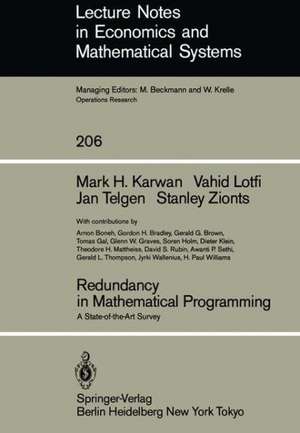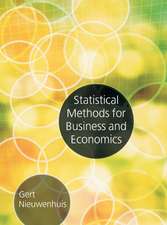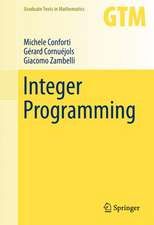Redundancy in Mathematical Programming: A State-of-the-Art Survey: Lecture Notes in Economics and Mathematical Systems, cartea 206
Autor M. H. Karwan, V. Lotfi, J. Telgen, S. Ziontsen Limba Engleză Paperback – apr 1983
Din seria Lecture Notes in Economics and Mathematical Systems
-
 Preț: 360.02 lei
Preț: 360.02 lei -
 Preț: 279.18 lei
Preț: 279.18 lei -
 Preț: 383.93 lei
Preț: 383.93 lei -
 Preț: 384.09 lei
Preț: 384.09 lei -
 Preț: 380.07 lei
Preț: 380.07 lei -
 Preț: 446.26 lei
Preț: 446.26 lei -
 Preț: 497.37 lei
Preț: 497.37 lei -
 Preț: 380.84 lei
Preț: 380.84 lei -
 Preț: 384.86 lei
Preț: 384.86 lei -
 Preț: 378.34 lei
Preț: 378.34 lei -
 Preț: 399.67 lei
Preț: 399.67 lei - 20%
 Preț: 360.93 lei
Preț: 360.93 lei - 15%
 Preț: 643.16 lei
Preț: 643.16 lei -
 Preț: 379.09 lei
Preț: 379.09 lei -
 Preț: 404.74 lei
Preț: 404.74 lei -
 Preț: 385.62 lei
Preț: 385.62 lei - 15%
 Preț: 644.49 lei
Preț: 644.49 lei -
 Preț: 379.09 lei
Preț: 379.09 lei -
 Preț: 345.50 lei
Preț: 345.50 lei -
 Preț: 425.80 lei
Preț: 425.80 lei -
 Preț: 378.34 lei
Preț: 378.34 lei - 18%
 Preț: 775.65 lei
Preț: 775.65 lei -
 Preț: 392.60 lei
Preț: 392.60 lei -
 Preț: 401.61 lei
Preț: 401.61 lei - 15%
 Preț: 646.43 lei
Preț: 646.43 lei -
 Preț: 382.18 lei
Preț: 382.18 lei -
 Preț: 378.34 lei
Preț: 378.34 lei - 15%
 Preț: 637.59 lei
Preț: 637.59 lei - 15%
 Preț: 647.27 lei
Preț: 647.27 lei -
 Preț: 377.73 lei
Preț: 377.73 lei -
 Preț: 447.84 lei
Preț: 447.84 lei - 15%
 Preț: 644.49 lei
Preț: 644.49 lei -
 Preț: 386.00 lei
Preț: 386.00 lei - 15%
 Preț: 654.43 lei
Preț: 654.43 lei -
 Preț: 415.02 lei
Preț: 415.02 lei -
 Preț: 411.54 lei
Preț: 411.54 lei -
 Preț: 398.92 lei
Preț: 398.92 lei -
 Preț: 398.92 lei
Preț: 398.92 lei -
 Preț: 392.75 lei
Preț: 392.75 lei - 15%
 Preț: 635.47 lei
Preț: 635.47 lei - 20%
 Preț: 653.56 lei
Preț: 653.56 lei -
 Preț: 379.86 lei
Preț: 379.86 lei -
 Preț: 495.46 lei
Preț: 495.46 lei -
 Preț: 447.99 lei
Preț: 447.99 lei -
 Preț: 378.71 lei
Preț: 378.71 lei - 15%
 Preț: 637.13 lei
Preț: 637.13 lei -
 Preț: 385.84 lei
Preț: 385.84 lei -
 Preț: 378.54 lei
Preț: 378.54 lei - 15%
 Preț: 666.55 lei
Preț: 666.55 lei
Preț: 642.68 lei
Preț vechi: 756.09 lei
-15% Nou
Puncte Express: 964
Preț estimativ în valută:
122.99€ • 126.89$ • 104.09£
122.99€ • 126.89$ • 104.09£
Carte tipărită la comandă
Livrare economică 04-18 martie
Preluare comenzi: 021 569.72.76
Specificații
ISBN-13: 9783540115526
ISBN-10: 3540115528
Pagini: 300
Ilustrații: VIII, 290 p.
Dimensiuni: 170 x 244 x 16 mm
Greutate: 0.48 kg
Ediția:Softcover reprint of the original 1st ed. 1983
Editura: Springer Berlin, Heidelberg
Colecția Springer
Seria Lecture Notes in Economics and Mathematical Systems
Locul publicării:Berlin, Heidelberg, Germany
ISBN-10: 3540115528
Pagini: 300
Ilustrații: VIII, 290 p.
Dimensiuni: 170 x 244 x 16 mm
Greutate: 0.48 kg
Ediția:Softcover reprint of the original 1st ed. 1983
Editura: Springer Berlin, Heidelberg
Colecția Springer
Seria Lecture Notes in Economics and Mathematical Systems
Locul publicării:Berlin, Heidelberg, Germany
Public țintă
ResearchCuprins
1. An Introduction to Redundancy.- 1.1 Redundancy.- 1.2 Causes of Redundancy.- 1.3 Consequences of Redundancy.- 1.4 Dealing with Redundancy.- 1.5 A Survey of the Literature.- 1.6 Objective and Plan of the Study.- 2. Mathematical Foundations and Notation.- 2.1 Notation.- 2.2 Terminology.- 2.3 A Categorization of Methods.- 2.4 Some Common Theory.- 3. A Method for Identifying Redundant Constraints and Extraneous Variables in Linear Programming.- 3.1 An Intuitive Exposition of the Approach.- 3.2 The Algorithm.- 3.3 Theory.- 3.4 An Example.- 3.5 Conclusion.- 4. A Method for Determining Redundant Constraints.- 4.1 An Intuitive Exposition of the Method.- 4.2 The Algorithm.- 4.3 Theoretical Background.- 4.4 An Illustrative Example.- 4.5 Conclusion.- 5. Identifying Redundancy in Systems of Linear Constraints.- 5.1 Introduction.- 5.2 Intuitive Exposition of the Approach.- 5.3 Description of the Algorithm.- 5.4 Mathematical Theory.- 5.5 Special Aspects of the Approach.- 5.6 Example.- 6. Finding Redundant Constraints in Sets of Linear Inequalities.- 6.1 Introduction.- 6.2 Intuitive Exposition of the Approach.- 6.3 The Algorithm.- 6.4 Mathematical Theory.- 6.5 Special Aspects of the Approach.- 6.6 An Example.- 6.7 Conclusion.- 7. A Method for Finding Redundant Constraints of a System of Linear Inequalities.- 7.1 An Intuitive Exposition of the Approach.- 7.2 Description of the Algorithm.- 7.3 Mathematical Theory.- 7.4 Special Aspects of the Approach.- 7.5 An Example.- 7.6 Conclusion.- 8. Some Reduction of Linear Programs Using Bounds on Problem Variables.- 8.1 Introduction.- 8.2 An Intuitive Exposition of the Approach.- 8.3 Description of the Algorithm.- 8.4 Mathematical Theory.- 8.5 Special Aspects of the Approach.- 8.6 An Example.- 8.7 Conclusion.- 9. A Reduction Procedure for Linear and Integer Programming Models.- 9.1 Introduction.- 9.2 Primal and Dual Observations.- 9.3 The Tests.- 9.4 Applying the Tests.- 9.5 Implementation Considerations.- 9.6 Numerical Examples.- 9.7 Conclusions.- 10. Preduce — A Probabilistic Algorithm Identifying Redundancy by a Random Feasible Point Generator (RFPG).- 10.1 Introduction.- 10.2 An Intuitive Exposition of Algorithm PREDUCE.- 10.3 Description of Algorithm PREDUCE.- 10.4 Mathematical Theory.- 10.5 Special Aspects of PREDUCE.- 10.6 A Numerical Example.- 11. The Noncandidate Constraint Method.- 11.1 Introduction.- 11.2 An Intuitive Explanation of the Method.- 11.3 Description of the Algorithm.- 11.4 Special Aspects of the Noncandidate Method.- 11.5 Solution of an Example.- 11.6 Conclusions.- 12. Structural Redundancy in Large-Scale Optimization Models.- 12.1 Introduction.- 12.2 Overview of the Analysis.- 12.3 Details of the Analysis.- 12.4 Extensions to Mixed Integer and Nonlinear Models.- 12.5 Conclusion.- 12.6 Acknowledgments.- 13. Programming the Methods and Experimental Design.- 13.1 Programming the Methods.- 13.2 Performance Monitoring.- 13.3 Test Problems.- 13.4 Summary.- 14. Results of the Sign Test Methods.- 14.1 Results for the Randomly Generated Problems.- 14.2 Problem Differences.- 14.3 Method Efficiencies Versus Time.- 14.4 Efficiency of the Various Tests.- 14.5 Results for the Structured Problems.- 15. Results of the Other Methods.- 15.1 Boneh’s Method.- 15.2 Mattheiss’ Method.- 15.3 Klein and Holm’s Method.- 15.4 Williams’ Method.- 15.5 The Method of Sethi and Thompson.- 15.6 Summary.- 16. Improvements and Extensions.- 16.1 The Extended Sign Test Method.- 16.2 The Hybrid Method.- 16.3 The Reduce Method.- 17. Results of the Improvements and Extensions.- 17.1 The Extended Sign TestMethod.- 17.2 The Hybrid Method.- 17.3 The Reduce Method.- 18. Conclusions.- 18.1 Summary of the Test Results.- 18.2 Other Developments and Conclusions.- References.









